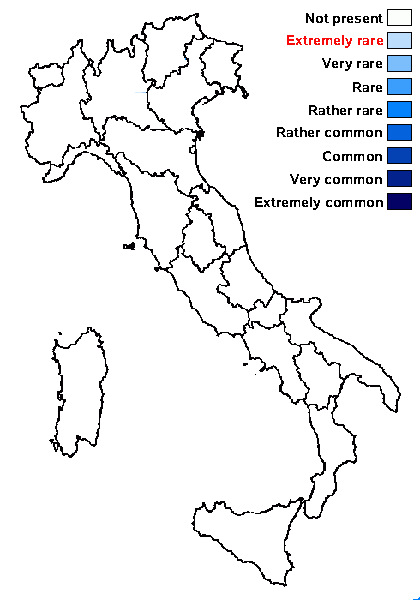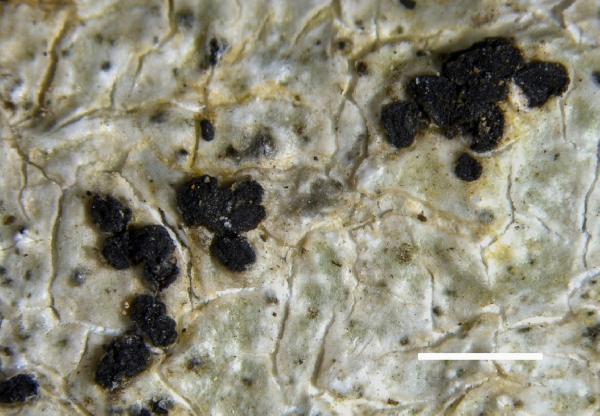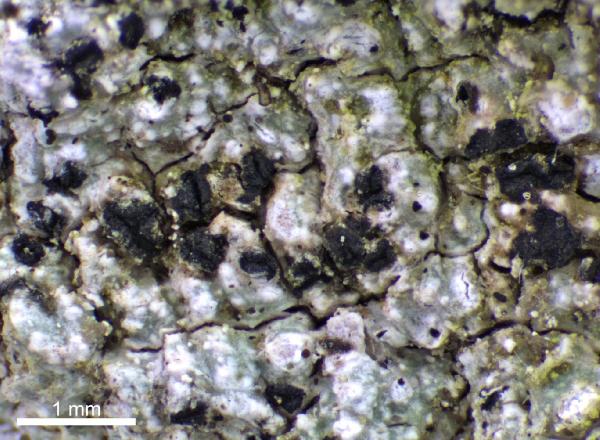Opegrapha anomea Nyl.
Act. Soc. Linn. Bordeaux 21, 4: 399, 1857.
Synonyms:
Distribution:
Description: Thallus inapparent, not lichenized, growing on the thalli of Lepra-, Ochrolechia- and Varicellaria-species. Apothecia round to angular or ellipsoid, 0.1-0.3 mm across, partly immersed in the host thallus and breaking through its cortex, usually gathered into up to 4 mm wide clusters, with a convex, black, epruinose, verruculose disc and a black, thick, radially sulcate proper margin. Proper exciple dark brown to black, K-, sometimes extending below the hymenium; epithecium brownish, K-; hymenium yellowish brown to colourless, 75-85 μm high, K-, I+ blue turning red, K/I+ blue; paraphysoids branched and anastomosing, 2-2.5 μm thick, the apical cells hardly swollen; subhymenium colourless to pale brown. Asci 4(-8)-spored, subclavate, the wall I-, K/I-, except for an apical K/I+ blue ring-structure in tholus. Ascospores 3-septate, slightly constricted at the median septum, hyaline but turning brown and coarsely verrucose at maturity, elongate-ellipsoid, 17-26 x 6.5-9.5 μm, with a distinct, c. 0.5 μm thick gelatinous perispore. Pycnidia black, immersed, located among the apothecia. Conidia narrowly bacilliform, 3.5-4 x 0.5-0.7 μm. Photobiont absent. Spot tests: K-, C-, KC-, P-. Chemistry: without lichen substances.Note: a lichenicolous fungus growing on the thalli of Lepra-, Ochrolechia- and Varicellaria-species; to be looked for in Italy.
Growth form: Lichenicolous fungus
Substrata: bark and rocks
Reproductive strategy: mainly sexual
paras Lepra, Ochrolechia and Varicellaria-species

Predictive model

Source: Frisch, A., Klepsland, J., Palice, Z., Bendiksby, M., Tønsberg, T. & Holien, H. 2020. New and noteworthy lichens and lichenicolous fungi from Norway. Graphis Scripta 32 (1): 1–47. Oslo. ISSN 2002-4495. - CC BY-4.0
Opegrapha anomea (TRH-L-16072). Scale = 1 mm. Photo: A. Frisch.

Source: Vicente, R., Westberg, M., Isaksson, R., Anderberg, R., Frisch, A., Hammarström, O., Hansson, J., Jonsson, F. & Svensson, M. 2024. Additions to the flora of lichenicolous fungi of Sweden II. Graphis Scripta 36 (7): 123–147. Oslo. ISSN 2002-4495 - CC BY-4.0
Apothecia on Lepra amara (UPS F-1086624).
Growth form: Lichenicolous fungus
Substrata: bark and rocks
Reproductive strategy: mainly sexual
paras Lepra, Ochrolechia and Varicellaria-species

Predictive model

Source: Frisch, A., Klepsland, J., Palice, Z., Bendiksby, M., Tønsberg, T. & Holien, H. 2020. New and noteworthy lichens and lichenicolous fungi from Norway. Graphis Scripta 32 (1): 1–47. Oslo. ISSN 2002-4495. - CC BY-4.0
Opegrapha anomea (TRH-L-16072). Scale = 1 mm. Photo: A. Frisch.

 INDEX FUNGORUM
INDEX FUNGORUM
 GBIF
GBIF

